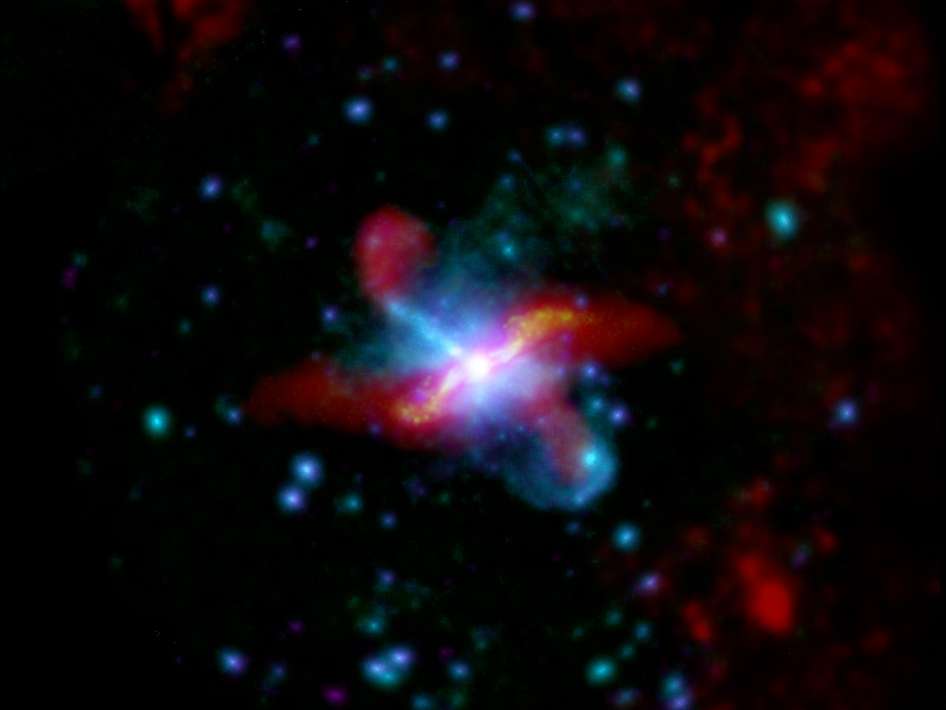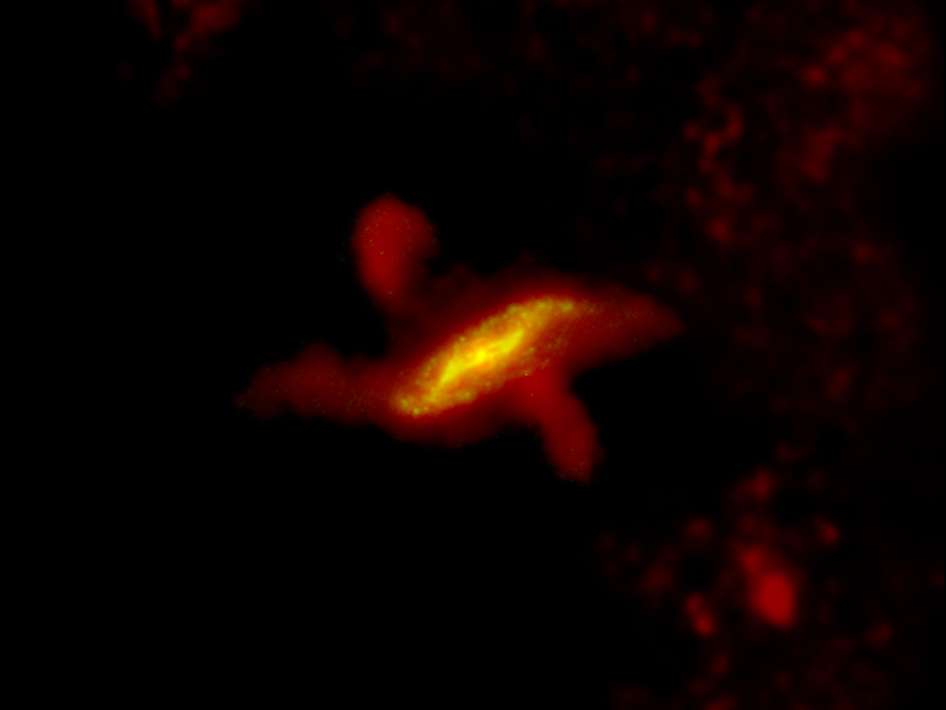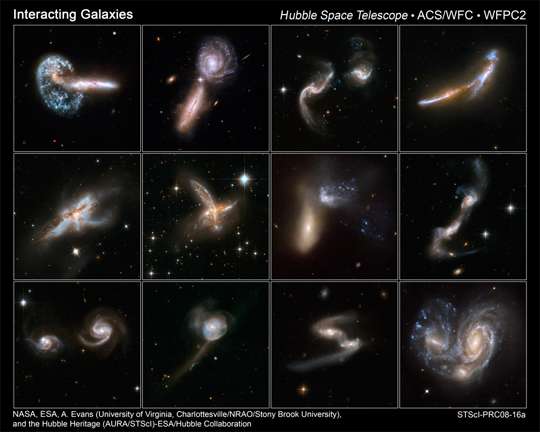It looks like you're using an Ad Blocker.
Please white-list or disable AboveTopSecret.com in your ad-blocking tool.
Thank you.
Some features of ATS will be disabled while you continue to use an ad-blocker.
10
share:

The peculiar galaxy Centaurus A as seen in longer infrared wavelengths and X-rays. Inner structural features seen in this image are helping scientists to understand the mechanisms and interactions within the galaxy, as are the jets seen extending over thousands of light years from the black hole believed to be at its heart. Image credit: Far-infrared: ESA/Herschel/PACS/SPIRE/C.D. Wilson, MacMaster University, Canada; X-ray: ESA/XMM-Newton/EPIC
Infrared and X-ray observations from two space telescopes have been combined to create a unique look at violent events within the giant galaxy Centaurus A. The observations strengthen the view that the galaxy may have been created by the cataclysmic collision of two older galaxies.
The infrared light was captured by the European Space Agency's Herschel Space Observatory, a mission with important NASA contributions. The X-ray observations were made by the European Space Agency's XMM-Newton space telescope.
Centaurus A is the closest giant elliptical galaxy to Earth, at a distance of around 12 million light-years. It stands out because it harbors a massive black hole at its core and emits intense blasts of radio waves.
Read the whole paper here

This Herschel Space Observatory image of Centaurus A combines long-wavelength infrared data from its Photoconductor Array Camera and Spectrometer (PACS) taken at 100 microns, and its Spectral and Photometric Imaging Receiver (SPIRE) instruments at 250, 350 and 500 microns. Image credit: ESA/Herschel/PACS/SPIRE/C.D. Wilson, MacMaster University, Canada
Interactions between galaxies gives sometimes uncommon and odd shapes....

Source
edit on 12-4-2012 by elevenaugust because: (no reason
given)
wow that is a sneak peak of what is to come, as the Andromeda galaxy is on a COLLISION COURSE with our own Milky way.
Colliding galaxies are one of the most beautiful sights...except for nebulas
reply to post by elevenaugust
J'aime espace cosmique!
Two ginormous galaxies colliding into each other...such epic proportions. You always deliver such interesting space-related threads. S&F
J'aime espace cosmique!
Two ginormous galaxies colliding into each other...such epic proportions. You always deliver such interesting space-related threads. S&F
I would imagine that for the inhabitants of the galaxies there some of them would get quite lucky with their solar system not getting too messed up by
gravitic chaos and not getting flung into deep space whereas others get really unlucky and get pounded with rogue stars and wandering black holes and
the occasional hypervelocity super-jupiter type objects. I can't imagine that would be fun for inhabited worlds though.
Originally posted by Mkoll
I would imagine that for the inhabitants of the galaxies there some of them would get quite lucky with their solar system not getting too messed up by gravitic chaos and not getting flung into deep space whereas others get really unlucky and get pounded with rogue stars and wandering black holes and the occasional hypervelocity super-jupiter type objects. I can't imagine that would be fun for inhabited worlds though.
maybe that's why they have come to earth (water planet in a stable galaxy). now they are trying to figure out how to intergrate, without having to dodge every tom, dick, and harry (human) with a gun, cannon, or missle trying to blow their ass away
reply to post by jimmyx
If they can cross galaxies why can't they just harvest comets and ice moons for water, organics, and other useful things terraform some place?
If they can cross galaxies why can't they just harvest comets and ice moons for water, organics, and other useful things terraform some place?
'new' images - keep in mind centaurus a is 12M light yrs away - show an extreme, explosively bright glow
Centauras A, the closest 'radio galaxy' to Earth, shows one system that lies within it ingesting another. Experts now think Centaurus A was formed by a merger between two separate galaxies -- and this new image goes a long way to backing that theory, it is claimed. The dusty band at the centre of the newly-released image is thought to be the mangled remains of a spiral galaxy being ripped apart by a giant elliptical galaxy.And the phenomenon is set to be a feature of our skies for a while yet as it will take another couple of hundred million years for the stricken system to fully disappear. Centaurus A has a central black hole with a mass of about 100 million times that of the Sun. Astronomers believe that this vast black hole produces the system's abnormally strong radio frequencies, as well as its bright nucleus and jet features.
reply to post by jimmyx
If they had the technology to get here they would have the technology to eradicate, subjagate, or force us into acceptance.
If they had the technology to get here they would have the technology to eradicate, subjagate, or force us into acceptance.
new topics
-
Putin, Russia and the Great Architects of the Universe
ATS Skunk Works: 2 hours ago -
A Warning to America: 25 Ways the US is Being Destroyed
New World Order: 7 hours ago
top topics
-
President BIDEN's FBI Raided Donald Trump's Florida Home for OBAMA-NORTH KOREA Documents.
Political Conspiracies: 12 hours ago, 31 flags -
A Warning to America: 25 Ways the US is Being Destroyed
New World Order: 7 hours ago, 13 flags -
Is AI Better Than the Hollywood Elite?
Movies: 14 hours ago, 4 flags -
Maestro Benedetto
Literature: 14 hours ago, 1 flags -
Putin, Russia and the Great Architects of the Universe
ATS Skunk Works: 2 hours ago, 1 flags
active topics
-
Gaza Terrorists Attack US Humanitarian Pier During Construction
Middle East Issues • 45 • : FlyersFan -
A Warning to America: 25 Ways the US is Being Destroyed
New World Order • 15 • : jidnum2 -
Chris Christie Wishes Death Upon Trump and Ramaswamy
Politicians & People • 25 • : RazorV66 -
Skinwalker Ranch and the Mystery 1.6GHz Signal
Aliens and UFOs • 145 • : Ophiuchus1 -
University of Texas Instantly Shuts Down Anti Israel Protests
Education and Media • 273 • : HerbertWest -
Krystalnacht on today's most elite Universities?
Social Issues and Civil Unrest • 6 • : FlyersFan -
Hate makes for strange bedfellows
US Political Madness • 50 • : 19Bones79 -
Weinstein's conviction overturned
Mainstream News • 28 • : burritocat -
Sunak spinning the sickness figures
Other Current Events • 25 • : Ohanka -
Cats Used as Live Bait to Train Ferocious Pitbulls in Illegal NYC Dogfighting
Social Issues and Civil Unrest • 24 • : NoviceStoic4
10
